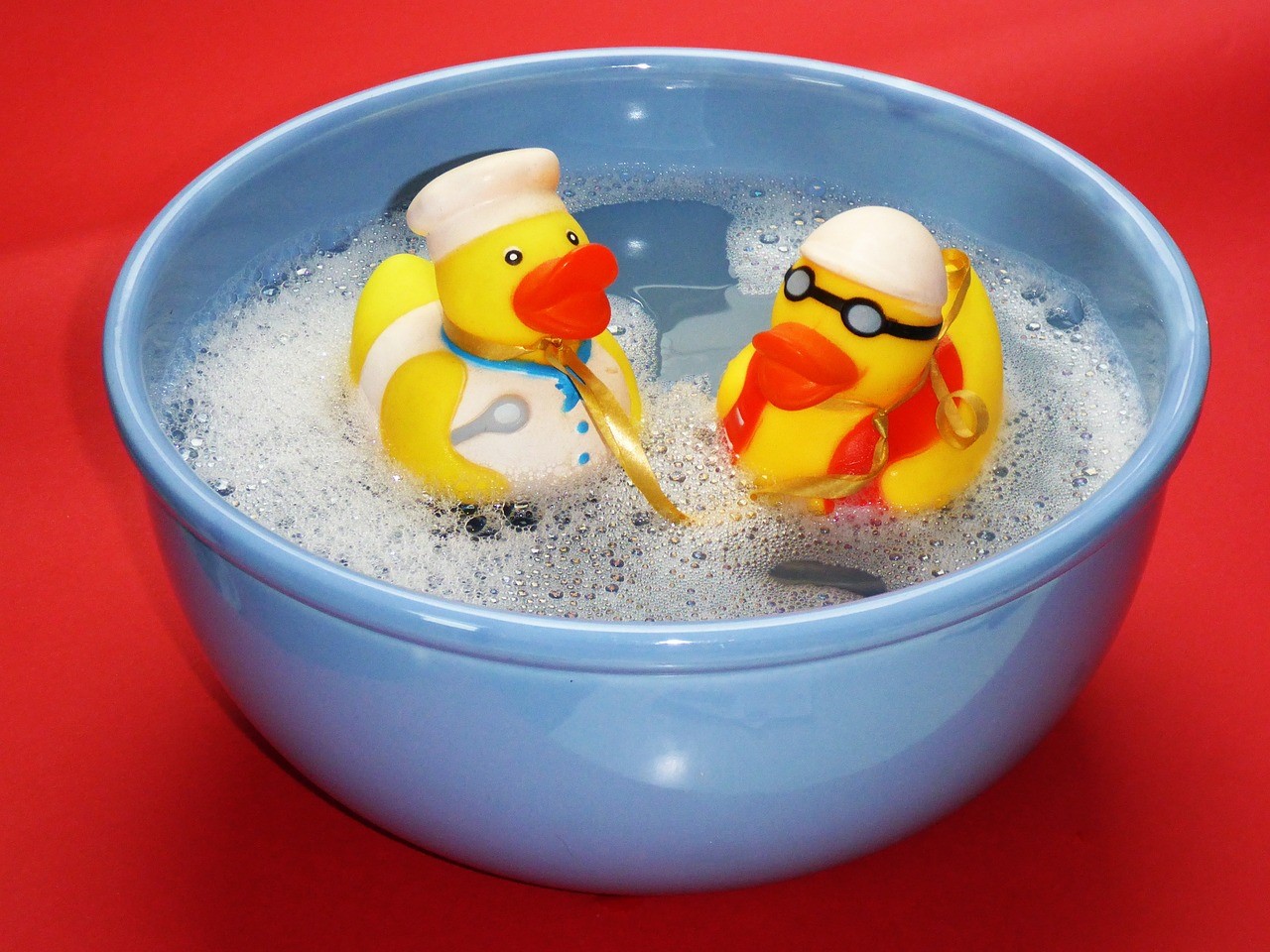Parenting
Bath Time Magic For Kids

Bath time is a perfect time for parents and children to get to know each other and spend quality time together.

How you view “bath time” is up to you. Many parents choose to treat it as a chore and dreadful evening. In many households, bath time is about as boring as brushing teeth. But if you want it to turn to special moments, you can do something to make you and your child feel excited about it. For a child, bath time should be a transition between the noisy and busy world of day and the peaceful, cozy world of bed. With very little effort on your part, you can make it a magic time for both of you.
How do you inject some magic into bath time? Make an extra effort for it. Create a schedule for bath time that works perfectly for your daily tasks. It should not be around your busy times as you don’t want your time with your child to be compromised. Phones and mobile gadgets should be off-limits during bath times. If the phone rings, leave the answering machine to pick it up. Clean the house before bath time so you can also prepare yourself for the transition of day and evening. Make sure that you set aside enough time so that you aren’t rushing and nagging your child to hurry.
Now, to make bath time fun! Here are some suggestions for adding magic.
Bubbles:

Essential Oils:

Two drops of lavender or chamomile essential oil (no more!) adding to the bath and stirring it will soothe and calm a fractious child after a long day. For variation, and to be sure that the oil disperses well, you can also add drops to a cup of milk before adding to the bath. We sometimes use an unscented mild bubble bath with the essential oil.
Candlelight for special occasions:

It is the only suitable for well-supervised bath times. Kids would also love the atmosphere of a candlelit bath. You should only lit the candles when your kids are taking a bath. Don’t leave it unattended to avoid accidents.
Warm towels and pajamas:

Children love to get out of the bath into a warmed towel and pajamas! This is true, especially during the winter season. Little touches make all the difference.
Poetry night:

Some households make bath time special by doing poetry night. Choose a day that you can spend the most time with your children. Search for poems in the library or on the internet. Then, you can print it and file it in plastic folders to keep them splash-proof. If possible, try to introduce an interesting variety of poems to the kids. In reality, we read the same favorite poems over and over again!
Bath Toys:

Bath toys are always something interesting to play with! It could be anything from sieves, whisks, measuring cups and jugs. There are times when kids would choose to play with your kitchen equipment. You can find other bath toys at garage sales and dollar stores. Plastic colander doubles would be excellent storage baskets.
Fun foam toys:

You can buy fun foam shapes in buckets, or you can buy the foam at the craft store and cut your own shapes. You can change the shapes to match holidays and seasons. It can be flowers for spring and summer, Christmas trees at Christmas, bunnies, and eggs at Easter. You can also cut pieces to teach colors, shapes, numbers or the alphabet. In this way, they can practice matching, grouping, sorting, ordering and so on.
Shaving foam sculpture:

Squirt a few large blobs of shaving foam onto the side of the bath or into your child’s hands. Warn him to keep it away from his eyes and let his imagination take over!
Music and story tapes:

Bath time is a good opportunity to introduce all kinds of music or to listen to a special story on tape or CD.
Blowing bubbles:

For a special treat, bring some bubble blowing mixture into the bathroom. Make sure that it doesn’t get into anyone’s eyes!
Colorful baths:

A few drops of food coloring will transform the bath into something exotic! Try orange or green at Halloween, red or green at Christmas, red for Valentine’s Day and so on. Keep the bottle well out of children’s reach!
Language night:

Bath time can also be you and your child’s language night. You can teach your kids English by listening to English tapes and singing English songs. You can decorate the room with small colorful posters. It can be made up of old exercise books or printing pages off the net. Laminate it and stick it on the bathroom walls. You can also put a label on the bath toys.
Finally, remember that in a few years your children will be old enough to take a shower or bath on their own. They might be resisting any attempt from you to interfere! Have you noticed how eagerly a grandmother runs her grandchild’s bath and splashes and plays for much longer than necessary? If you asked her, she would tell you to make the most of the bath time while you can. Whatever you do during bath time will be worth it. You and your children can look back happily on those special memories.
You may like
Parenting
Strategies for Resolving Conflict with Your Children

Conflicts between parents and children have gone on since time began. As a child starts to learn how to talk, it seems they have likewise learned how to say ‘no.’ And they often say it often about everything from bedtime to eating their vegetables. What’s even more maddening is when they fight you on things you know they do want, like a trip to the park. It begins to seem as though children exist to be contrary.
Thankfully there’s help available. Below is a list of four strategies that will help you resolve conflicts with your child. What’s even more amazing is that these techniques work well whether you’re dealing with a toddler or a teenager.
- Don’t get sucked into the tension of the moment. Conflict with children quickly escalates. One demand becomes another until you’re so wrapped up in the whirlpool that you can no longer think or make a rational decision. At that moment you need to step back and take some time away. Take a deep breath and be calm. It might be time to let someone else watch the kids while you step outside and take a walk.
Walking away from a conflict with your child is something of an art. The last thing you want is for the child to think you’re not listening to what they have to say. But every argument reaches that point where no one is saying anything new. It’s about here that things start to get personal, and indeed uncomfortable. That is the point of taking a break. But even this takes skill. Excuse yourself quietly. It’s not the time for a dramatic exit. Whatever the case, you’re going to have to let your own emotions steady out before trying to help your child to calm theirs.
- Calm down. Clearing your head will help you to be both calmer and more rational. Once you’ve removed yourself from the situation, then take a few minutes for yourself. Breathe deeply. Practice mindfulness or even a lot of prayer until you’re in a better place and able to be in control of yourself. Find that inner peace.

- Become an active listener. When your child is upset about something, before assuming they’re wrong, ask them to explain why they’re upset. Then listen to their answer. Ask questions. Clarify. And then repeat back to them what you thought you heard them say. It might be that they have a legitimate concern. Or it might be they’ve misunderstood the situation completely. Either way, you’re now in a better position to help find a resolution to the situation.
- Practice empathy. Realize that there might be something more going on with your child than there appears to be on the surface. That will not only help you to calm down, but also might show you a possible solution, or at least a new way to address your child in a way that’s respectful and more compassionate. Keep in mind that your insights might well show you that the problem is with you.

Source: Pixabay - Empower your child. Allow them to make some of their own decisions. For example, rather than getting involved in a long fight over what to wear, allow your toddler to choose at least part of their outfit. It’s about learning how to pick your battles, saving the fights for the things that matter.
- Reconcile. Try apologizing. Recognize that it does take two people to get into an argument. Apologizing acknowledges the part that you’ve played in the situation and invites your child to do the same. This is a great way to teach your child how to resolve conflicts in a healthy way.
- Reconcile. Try apologizing. Recognize that it does take two people to get into an argument. Apologizing acknowledges the part that you’ve played in the situation and invites your child to do the same. This is a great way to teach your child how to resolve conflicts in a healthy way.

Source: Pixabay You don’t have to live in dread of a conflict with your child. Having conflict is inevitable. What you do need is to learn how to take back control when the conflicts happen. How you deal with conflict says a great deal about you as a parent.
Remember, it’s up to you to decide how you want to react to these situations. Being able to keep your cool in trying situations is an invaluable skill and one well worth cultivating, especially in parenting.
By staying calm and practicing these steps and you’ll soon find the road back to a peaceful resolution with your child, regardless of their age. And in the process teaching them the invaluable lesson of dealing with conflicts in a healthy way.
Parenting
So You Have A Picky Eater?


If you have a picky eater, mealtime can make you feel like you want to pull your hair out. It is frustrating for parents to watch their child only fiddle with their food at dinner or not even touch it, claiming they “don’t like it.” So what happens? Thirty minutes later guess who is hungry? You guessed it. Your little picky eater.
Jamie’s mother was concerned about Jamie’s lack of interest in food. She stated, “Jamie never wants to eat anything I fix for dinner. What can I do to encourage Jamie to eat the meals that I have prepared?” I came up with the following ten tips for her. You may find them useful as well.
TIP: INVOLVE JAMIE. You can have Jamie help with planning the menu or meal preparation. Kids are less likely to “turn up their nose” at something, they had a hand in.
TIP: PLACE A LIMIT ON JAMIE. Let’s think that Jamie is playing with her food at dinner and not really interested in eating it. Mom says, “Jamie, I will be serving breakfast at 7:00 a.m. try to eat enough to make it to then. You decide how much you will need. Oh! We will be clearing the table in _____ minutes.”
When Jamie comes to you later that evening complaining of being hungry. With an understanding tone, remind her that you will be serving breakfast at 7:00 a.m. as usual. Jamie will most likely be persistent about getting something else to eat. It is important that you follow through with the limit you have placed. Otherwise, Jamie learns that you do not mean what you say and you lose your credibility with her. You may have to tell her several times that you will be “serving breakfast at 7:00” until she realizes that you’re not going to give in.
Jamie: “Mom I’m hungry. Can I have some cookies?”
Mom: “Kids who eat all their dinner are welcome to have a snack after.”
Jamie: “But mom I’m really hungry.”
Mom: “I know Jamie. I would be hungry too if I ate as little as you did for dinner, but don’t worry I will be fixing a big breakfast at 7:00 a.m.”
Jamie: “What? Do you want me to starve?”
Mom: “I’ll be serving breakfast at 7:00 Jamie”
Jamie: “This isn’t fair.”
Mom: “I’ll be serving breakfast at 7:00 Jamie”
Jamie: “Fine!”
TIP: NOTICE THE EXCEPTIONS. Call attention to the times when Jamie eats most of her meals. “Wow! Jamie, you ate everything on your plate. Good job. You should be proud of yourself.” Too often, we only notice the negative aspects of our children’s behavior and that is what we reinforce with our negative attention.

TIP: CATER TO JAMIE’S DESIRE TO BE “BIG”. “ You won’t like this halibut, Jamie. Usually, adults are the only ones who like halibut.” Guess what may just become Jamie’s new favorite food?

TIP: PROVIDE VARIOUS CHOICES AROUND MEALTIME. “Would you rather sit by me or by mommy?” “You can eat with a fork or a spoon which would you prefer?” “Do you think you will need more potatoes or is that enough?” “Have as much as you think you will need to make it to dinner.” “Milk or juice?” “Should we eat at 7:00 or 7:30?”

TIP: BE A GOOD ROLE MODEL. “You know dear, although spaghetti is not my favorite, I will eat it because I know how hard you worked to make it.”

TIP: EXPOSURE. Encourage Jamie to try a variety of foods early on in her life before she knows anything different. Some children may have never thought eating liver was gross if it hadn’t been for what someone else had set their expectation to be.

TIP: PROVIDE SOME FLEXIBILITY. Let’s remember there are some foods that certain children can not stomach. If Jamie has a problem with spinach, but it is part of that particular meal, try to have other items. This way she can get her fill up on once everyone has their share. But, this should be the exception rather than the rule.
Try letting Jamie dip her food in sauces, dressings, syrups, and ketchup. It may make them taste better to her.

TIP: MAKE MEALTIME ENJOYABLE. Try to talk about things other than eating at mealtime. Dinner is a great time to talk to Jamie about how her day went. During breakfast, you can discuss what everyone has planned for the day.
Anyone pitching in to help prepare a meal can teach Jamie an important family value. An added bonus for children is that it can teach them important skills. It can be about thinking skills like timing, measuring, colors, comparisons, counting, and cause and effect.
Be creative in the ways that you dish up Jamie’s food. Mold her mashed potatoes into a volcano. Then, cut her meat or sandwich into bite-sized pieces. Poke toothpicks in them and layout veggies in the shapes of letters or numbers. You can also use a drop or two of food coloring to make it more interesting.

TIP: LIMIT SNACKING. For children to be hungry enough to eat a meal they usually need to go two or three hours without food. However, it is difficult for children to go from noon to 6:00 p.m. without food. A nutritious snack after school would be fine to get Jamie to dinner, still having her appetite.

TIP: RECALL PAST SUCCESSES. Think back to the times when Jamie had eaten her meals. What were you doing? Were you placing a lot of emphasis on her need to eat her food? What was she doing? What were you eating? What happened before the meal? These kinds of questions may help you realize some of the things you or Jamie is already doing which assist her in becoming a better eater.
Parenting
Six Ideas To Help You Discipline Your Kid


Got a kid? Love him or her? Of course, you do. So when he or she misbehaves on a consistent basis, what’s the best way to administer discipline?
Well, as you may be aware, there is a wide range of thoughts on this subject. One school of thought teaches hands-off to let the children figure it all out on their own. No punishment or reward systems. Another extreme says that the Singapore model of “canning” people for littering is a good one.
Most of us find ourselves between these two nutty positions. And the word “nutty” is being charitable. If you don’t think so, then stop reading. You’re a lost cause and should find yourself in a nice rubber room so that you don’t hurt yourself or anyone else.
Every child responds to anything in different ways. Some kids have a very high “pain” threshold. They can take whatever penalties you exact as they stubbornly refuse to do what they should do. There are others who can be easily motivated by various token systems.
So how do you find out what method of discipline will work for your kid(s)?
In a word: experiment! Here are six ideas for proceeding.
#1 – Put on your “scientist hat.”Research what’s out there. No author knows your kid better than you do. Many research studies can lead to various strategies for your kids. So knowing what’s been done before is a very good strategy in and of itself.
#2 – Once you know what you can do, you can now start interacting with your kid(s). Learn to differentiate discipline and abuse as we live in a reality wherein two can be seen as the same thing. So be careful as you try different discipline ideas.
Important note: Remember your main goal in doing these ideas. If you want to raise good and intelligent children, be patient to see if one thing applies to your children.
#3 – When you find something that seems to work, don’t think you can finally relax. Don’t confuse short term hits with long term success. Your child may be responding well to your discipline. But when it wears off, your child may very well revert to the old behaviors that you tried to change. The tough phase will last for more than a few weeks. So give things at least 3-6 weeks to see if the changes are enduring.
#4 – Tweak before you make major changes in your efforts. For example, suppose you are rewarding your kid(s) with pizza at the end of the week if they do something right. You assume that they’re responding to novelty rather than the measures themselves. Rather than junking the measures, tweak them a bit to determine if your suspicion is valid. For example, you might vary the food rewards. Say, “Look – if you do good things, you get to pick what we have for Friday dinner.” You might be on the right track and tweaking gives you a chance to really find out.
#5 – If tweaking doesn’t work, then, by all means, try new approaches.
#6 – Finally, be humble enough to know that you might need professional support. This can be in the form of a therapist or counselor. You’ve got to be careful here because these professionals have different competency levels on how to deal with your case. Some would suggest certain drugs as the initial therapeutic intervention for your child. You have the right to be skeptical in such situations. Listen to your own inner voice here. No matter how good the intentions are, many therapists simply get things wrong. If the one you’ve initially selected isn’t right for your child or your family, try another.
There are also organizations that can help you find a decent therapist that you need. America and many other nations are rich in resources to help families. Look into them if your problems grow too intense for you to handle on your own.
Finally, use common sense. It may sound strange but you’ll be the only one to make the final decision. Regardless of any professional help, books, or online forums that you encounter, you’ll be responsible for your child. Use the best intelligence you can and proceed with caution.



